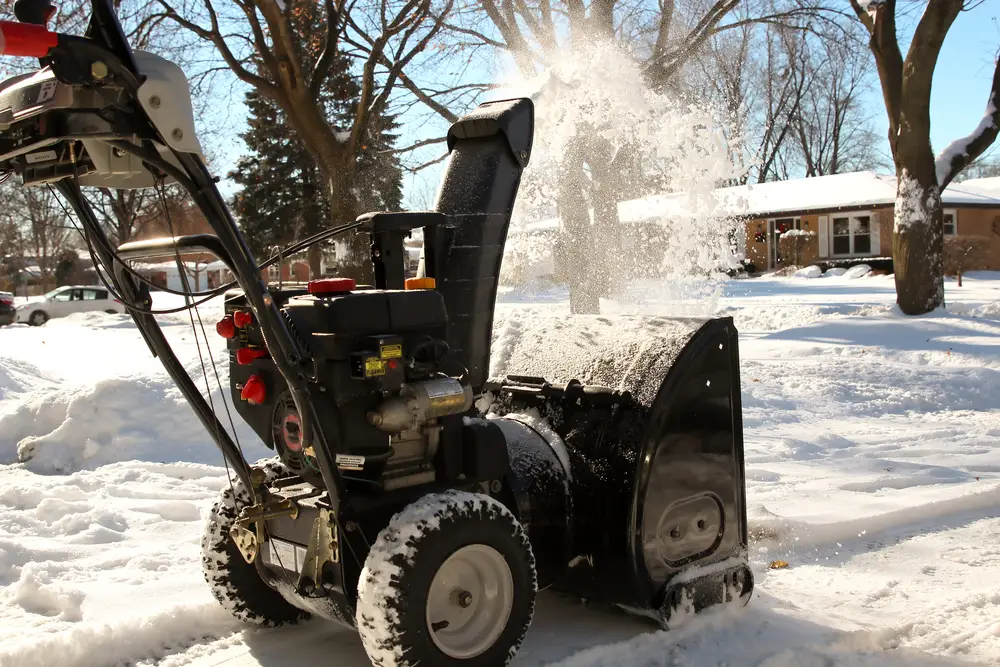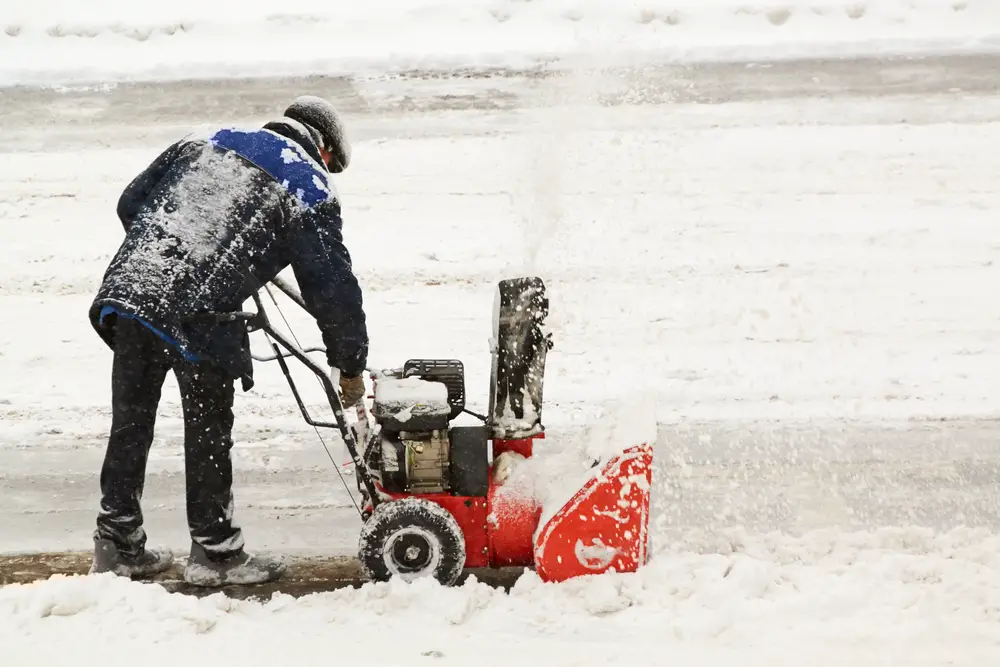A snow blower is one of the best ways to clear your driveway and walkways from accumulating snow. Unfortunately, it isn’t self-explanatory, and if you don’t use it right, you can cause more problems for yourself than necessary.
It is important to remember that snow blowers are heavy machinery with many hot, sharp, and moving parts that can be hazardous if you don’t take the proper precautions.
Let’s take a look at some of the best tips and tricks for properly using a snow blower and follow detailed instructions on how to operate this fantastic snow-annihilating machine.
What Is a Snow Blower?
Before successfully operating a snow blower, you must know what one is.
While you have probably seen these babies in action, you might not know what it is doing or how it is doing it.
A snow blower, also known as a snow thrower, is a machine that runs on gas or electric power that tosses mounds of snow up to fifty feet from its original location.
There are various versions of these snow machines, but all of them do pretty much the same job: lifting snow and propelling it into a direction that will keep it out of the way.
Parts of a Snow Blower
Whenever you use a snow blower, you always want to check it thoroughly and ensure all the parts are clean and in the proper position. To do this, you need to know each of the essential parts.
The four major components of a snow blower are:
- Auger
- Control parts
- Engine
- Drive parts
The auger is the part of the snow blower that moves the snow around and shoots it out the side. The auger has multiple blades that constantly rotate and throw snow out of the auger housing unit and chute.
The control parts are the pieces that control the machine and tell it what to do. The control parts are belts, cables, and pulleys that govern the blower and connect it to the control box.
Next, there is the engine. Like everything else with an engine, its job is to get the machine up and running and keep it powered while it moves.
Lastly, there are the drive parts. The drive parts are designed to steer and control the snow blower in whichever direction you guide it.
All the parts are crucial to the operation of your snow blower and ensuring that you get the most out of each push. Keeping these parts and pieces in pristine condition is essential to keep your snow blower working to the best of its ability.

Safety Guide to Using a Snow Blower
It might not look like it, but using a snow blower can be dangerous if not done properly. You must follow certain safety measures to get the job done without serious issues.
- Always wear safety goggles: Keep your eyes protected while snow is blowing. Safety goggles will protect you from shooting snow, ice, and salt.
- Dress for the weather: If you are using the snow blower, it is safe to say it is cold outside. Dress warm, wear proper foot attire, and always wear gloves to avoid frostbite.
- Don’t wear baggy clothing: Keep your clothes tightly fitted when dressing in layers. Serious injuries can occur if your clothes get caught up in the blades.
- Don’t mess with a hot engine: Ensure the engine cools down before refueling or checking the fuel. The engine gets very hot with use.
- Never put your hands near the moving pieces: The moving parts on a snow blower include the auger, chute, and collector.
- Never let the machine run unattended: Don’t leave the snow blower running unless you are using it. You should also keep it from idling inside a garage or shed due to the dangers of carbon monoxide.
- Wear proper footwear: Snow and ice are very slippery; when snow blowing, make sure you wear a pair of boots with excellent grip.
Step By Step Guide on Operating a Snow Blower
Now that you know all the working parts of your snow blower, you are probably interested in knowing how to use it, right?
Here is a step-by-step instruction guide on properly operating a snow blower.
Step One: Map Out Your Route
Before starting the engine, you must know exactly where you plan on starting and how much you plan to clear away. Pushing a snow blower across the driveway will feel like push-mowing your lawn, going back and forth in lines to get the job done.
- Decide where the snow should go: Figure out which direction is best to blow the snow, so you aren’t creating a bigger issue for yourself.
- Factor in the weather: If it is still snowing or windy, which can significantly impact the blowing snow, you will want to direct your blower to go with the wind.
- Toss it in the appropriate direction: Be courteous when snow blowing; don’t aim the blower toward the street, sidewalk, or your neighbor’s driveway.
Step Two: Prepare the Snow Blower for Use
Now that you have a plan in place, double-check that the snow blower is ready to go.
Maintaining a snow blower yearly will help prolong its life and keep it up and working in optimal condition.
- Check the engine oil.
- Remove any old debris from the belt and augur.
- Inspect the tire pressure.
- Ensure all nuts and bolts are tight.
Step Three: Start it Up
Once the snow blower is in good working condition, it is time to start it up and get going. Before doing this, you should decide where on the property is the best and easiest place to start and where you would like to end up.
- Place the snow blower into the starting position and turn it on.
- Adjust the augur housing chute in the direction you want the snow to go. Make sure it is facing somewhere that doesn’t need to be cleared, like the side of a driveway or sidewalk.
- Push the snow blower in the direction you want it to go while slowly walking behind it, guiding it on its course.
- Once you get to the end of one row, turn off the augur, reposition the blower, turn it back on, and continue clearing your driveway, now going the opposite way. (Don’t forget to change the direction of the shoot.)
- Continue this process until the entire space is clear.
Consider taking breaks in between each large section. A snow blower is easier to use than a shovel, but it is still hard work. There is no need to rush, and it would be better for you and your health to take a few breaks.
Step Four: Store and Maintain Your Snow Blower After Each Use
The best way to ensure your snow blower will work properly is by ensuring that it is taken care of and stored every time you use it.
After each use, wipe down and dry your blades and the housing unit. This will keep the machine from rusting and wearing too quickly. Once the machine is dried, store it in a garage or shed that has adequate space and stays dry.
While storing it inside is a great way to keep it clean and ready to go for the next snowfall, investing in a cover is a good idea.
Follow a Maintenance Schedule
Even though you don’t use your snow blower every season, you shouldn’t forget it exists until the snow has accumulated and you need it to work its magic.
Many professionals suggest following a maintenance schedule to keep your blowing in adequate condition all year round, so you aren’t surprised with tons of needed repairs when winter hits.
Before Winter Tasks
A month or so before the snow starts to fall, you should check over your snow blower to ensure it is in working condition.
- Check the spark plugs and belts for cracks or damages and replace them if needed.
- Check the oil and make sure it is full and clean.
- Take care of any rust spots so they do not get worse once the weather hits.
- Wax the inside of the snow blower chute. Doing this will keep the snow from clogging.
- Lubricate any part that requires it according to the owner’s manual.
After Winter Tasks
Once the snow has melted and there aren’t any flurries left in the forecast, it is probably safe to pack your snow blower up and put it away until next winter.
Before you cover it up and sit it in the corner, there are a few things you need to do first.
- Wipe down the entire machine inside and out. You want to ensure you remove all salt and water to prevent rust and corrosion.
- Drain the snow blower of all fluids, from the engine oil to the gasoline. You can run the tank until empty or use a siphon to get those last drops.
- Add some quality fogging oil to the engine to keep the snow blower’s inner workings in check during the off-season.
- Wipe lubricant on the necessary parts according to your owner’s manual.

Tips and Tricks to Consider When Operating a Snow Blower
Although snow blowing seems pretty straightforward, there are some tips and tricks to consider that will make this task easier and keep you from ruining your machine.
1. Don’t Wait for the Snow to Stop Falling
Don’t wait for the snow to stop falling before you head out to blow it away. If you live somewhere where snow tends to build up fast, it is best to go out while it is still coming down.
Removing the snow layer by layer will be much easier and less painful when pushing through it.
2. Take Your Time
This isn’t a fun activity for most people and can be a very mundane and time-consuming task. However, pushing through too quickly can clog up the machine and make getting the area clear much more difficult.
Take your time and walk slowly, allowing the snow blower ample opportunity to pick up all the snow and move it properly.
3. Use a Fuel Stabilizer
Always pour a container of fresh fuel stabilizer into your snow blower’s fuel tank, mixing it with your first full tank of gas. Doing this will help keep your engine running smoothly and make your job less stressful.
4. Spray the Auger and Shoot with Vegetable Spray
Use vegetable spray or lubricant on your auger and the snow blower chute to keep it from clogging and stop the snow from sticking to the machine.
5. Take on Smaller Portions at a Time
You are in a hurry to get back into the house, and we get that, but scooping up more than your blower can handle will prolong the snow-blowing process.
By scooping up smaller amounts at a time, you will get through the process efficiently and won’t risk having to stop constantly to unclog your auger.
6. Purchase a Waterproof Extension Cord
If you are using a corded snow blower, you must ensure the extension cord you use is designed for getting wet, for obvious reasons.
Summing Things Up
Using a snow blower during the winter is one of the best snow removal toolsto keep your driveway, sidewalks, and parking lots snow-free and safe to walk on.
Because the machines are so important, you want to ensure you know exactly what you are doing, which is why we created this helpful guide. The guide should answer all the questions you might have and will help you clear the snow from your space in no time at all.





